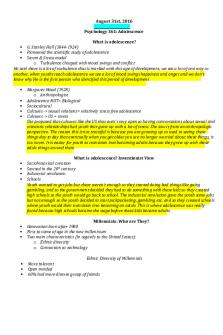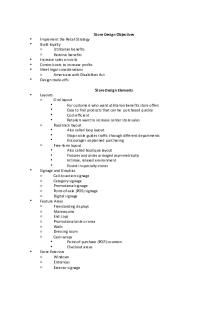Chapter 36.1 notes - harvill PDF

| Title | Chapter 36.1 notes - harvill |
|---|---|
| Course | Mod Concepts Bioscience Cont |
| Institution | Baylor University |
| Pages | 2 |
| File Size | 67.7 KB |
| File Type | |
| Total Downloads | 14 |
| Total Views | 145 |
Summary
harvill...
Description
Chapter 36.1 BioFlix: Water Transport in Plants Animation: Transpiration; Animation: Water Transport Concept 36.4: The rate of transpiration is regulated by stomata Leaves generally have large surface areas and high surface-to-volume ratio These characteristics increase photosynthesis, but also increase water loss through stomata Guard cells help balance water conservation with gas exchange for photosynthesis Stomata: Major Pathways for Water Loss About 95% of the water a plant loses escapes through stomata Each stoma is flanked by a pair of guard cells, which control the diameter of the stoma by changing shape Stomatal density is under genetic and enviormental control Mechanisms of Stomatal Opening and Closing Changes in turgor pressure open and close stomata When turgid, guard cells bow outward and the pore between them opens When flaccid, guard cells become less bowed and the pore closes Figure 36.13 This results primarily from the reversible uptake and loss of potassium ions (K ) by the guard cells Stimuli for Stomatal Opening and Closing Generally, stomata open during the day and close at night to minimize water loss Stomatal opening at dawn is triggered by Light CO depletion An 2internal “clock” in guard cells All eukaryotic organisms have internal clocks; circadian rhythms are 24-hour cycles Drought, high temperature, and wind can cause stomata to close during the daytime The hormone Abscisic acid (ABA)) is produced in response to water deficiency and causes the closure of stomata Effects of Transpiration on Wilting and Leaf Temperature Plants lose a large amount of water by transpiration If the lost water is not replaced by sufficient transport of water, the plant will lose water and wilt Transpiration also results in evaporative cooling, which can lower the temperature of a leaf and prevent denaturation of various enzymes involved in photosynthesis and other metabolic processes Adaptations That Reduce Evaporative Water Loss Xerophytes are plants adapted to arid climates Some desert plants complete their life cycle during the rainy season Others have fleshy stem that store water or leaf modifications that reduce the rate of transpiration Some plants use a specialized form of photosynthesis called crassulacean acid metabolism (CAM) where stomatal gas exchange occurs at night Figure 36.14 Concept 36.5: Sugars are transported from sources to sinks via the phloem The products of photosynthesis are transported through phloem by the process of translocation Movement from Sugar Sources to Sugar Sinks In angiosperms, sieve-tube elements are the conduits for translocation Phloem sap is an aqueous solution that is high in sucrose It travels from a sugar source to a sugar sink A sugar source is an organ that is a net producer of sugar, such as mature leaves A sugar sink is an organ that is a net consumer or storer of sugar, such as a tuber or bulb
In many plants, phloem loading requires _____
Proton pumping and cotransport of sucrose and H enable the cells to accumulate sucrose At the sink, sugar molecules diffuse from the phloem to sink tissues and are followed by water Bulk Flow by Positive Pressure: The Mechanism of Translocation in Angiosperms Phloem sap moves through a sieve tube by bulk flow driven by positive pressure called pressure flow Animation: Translocation of Phloem Sap in Spring; Animation: Translocation of Phloem Sap in Summer...
Similar Free PDFs

Chapter 36.1 notes - harvill
- 2 Pages

Chapter 26 notes - Harvill
- 2 Pages

Chapter 23 notes - Harvill
- 4 Pages

Chapter 42 notes - Harvill
- 6 Pages

Chapter 48 notes - Harvill
- 4 Pages

Chapter 53-2 - Harvill
- 4 Pages

Tutorial Chapter 2 CHM 361
- 2 Pages

Psychology 361 Notes 1-3
- 19 Pages

Chem 361 lab 4
- 5 Pages

Music 361 Syllabus F2020
- 12 Pages

COMP-361 10 Behavioural Design
- 37 Pages

MKT 361 Final Marketing Plan
- 13 Pages
Popular Institutions
- Tinajero National High School - Annex
- Politeknik Caltex Riau
- Yokohama City University
- SGT University
- University of Al-Qadisiyah
- Divine Word College of Vigan
- Techniek College Rotterdam
- Universidade de Santiago
- Universiti Teknologi MARA Cawangan Johor Kampus Pasir Gudang
- Poltekkes Kemenkes Yogyakarta
- Baguio City National High School
- Colegio san marcos
- preparatoria uno
- Centro de Bachillerato Tecnológico Industrial y de Servicios No. 107
- Dalian Maritime University
- Quang Trung Secondary School
- Colegio Tecnológico en Informática
- Corporación Regional de Educación Superior
- Grupo CEDVA
- Dar Al Uloom University
- Centro de Estudios Preuniversitarios de la Universidad Nacional de Ingeniería
- 上智大学
- Aakash International School, Nuna Majara
- San Felipe Neri Catholic School
- Kang Chiao International School - New Taipei City
- Misamis Occidental National High School
- Institución Educativa Escuela Normal Juan Ladrilleros
- Kolehiyo ng Pantukan
- Batanes State College
- Instituto Continental
- Sekolah Menengah Kejuruan Kesehatan Kaltara (Tarakan)
- Colegio de La Inmaculada Concepcion - Cebu



